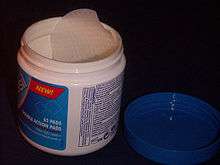Medical uses of salicylic acid
Salicylic acid is used as a medicine to help remove the outer layer of the skin.[1] As such it is used to treat warts, calluses, psoriasis, dandruff, acne, ringworm, and ichthyosis.[1][2] For conditions other than warts, it is often used together with other medications.[2] It is applied to the area affected.[1]
 Cotton pads soaked in salicylic acid for medical use | |
| Clinical data | |
|---|---|
| AHFS/Drugs.com | Multum Consumer Information |
| Routes of administration | topical |
| ATC code | |
| Legal status | |
| Legal status |
|
| Identifiers | |
| CAS Number | |
| PubChem CID | |
| DrugBank | |
| ChemSpider | |
| Chemical and physical data | |
| Formula | C7H6O3 |
| Molar mass | 138.122 g·mol−1 |
| 3D model (JSmol) | |
SMILES
| |
InChI
| |
Side effects include skin irritation, and salicylate poisoning.[2] Salicylate poisoning tends to only occur when applied to a large area and in children.[2] Use is thus not recommended in children less than two years old.[2] It comes in a number of different strengths.[3]
Salicylic acid has been in medical use since at least the time of Hippocrates.[4] It is on the World Health Organization's List of Essential Medicines, the most effective and safe medicines needed in a health system.[5] In the United Kingdom 10 ml of a 17% liquid formulation costs the NHS about £1.71.[3] It is also available mixed with coal tar, zinc oxide, or benzoic acid.[3]
Medical uses
Salicylic acid as a medication is used to help remove the outer layer of the skin.[1] As such it is used to treat warts, calluses, psoriasis, dandruff, acne, ringworm, and ichthyosis.[1][2]
Because of its effect on skin cells, salicylic acid is used in some shampoos to treat dandruff.
In modern medicine, salicylic acid and its derivatives are constituents of some "skin-reddening" products.
Side effects
Concentrated solutions of salicylic acid may cause hyperpigmentation on people with darker skin types (Fitzpatrick phototypes IV, V, VI), without a broad spectrum sunblock.[6][7] Due to sun sensitivity, sun protection is recommended when using salicylic acid on sun-exposed skin.[8]
Pregnancy
No studies examine topical salicylic acid in pregnancy. The risks of aspirin late in pregnancy are probably not relevant for a topical exposure to salicylic acid, even late in the pregnancy, because of its low systemic levels. Topical salicylic acid is common in many over-the-counter dermatological agents and the lack of adverse reports suggests a low risk.[9]
Overdose
Side effects include skin irritation, and salicylate poisoning.[2] Salicylate poisoning tends to only occur when applied to a large area and in children.[2] Use is thus not recommended in children less than two years old.[2] It comes in a number of different strengths.[3]
Salicylic acid overdose can lead metabolic acidosis with compensatory respiratory alkalosis. In people presenting with an acute overdose, a 16% morbidity rate and a 1% mortality rate are observed.[10]
Mechanism of action
Salicylic acid works as a keratolytic, comedolytic and bacteriostatic agent, causing the cells of the epidermis to shed more readily, opening clogged pores and neutralizing bacteria within, preventing pores from clogging up again and allowing room for new cell growth.[11][12]
History
Historically salicylic acid is known for its ability to ease aches and pains and reduce fevers.[11] These medicinal properties, particularly fever relief, were discovered in ancient times. It has been also used as an anti-inflammatory drug.[11]
References
- "Salicylic acid topical medical facts from Drugs.com". www.drugs.com. Archived from the original on 18 September 2017. Retrieved 15 January 2017.
- WHO Model Formulary 2008 (PDF). World Health Organization. 2009. p. 310. ISBN 9789241547659. Archived (PDF) from the original on 13 December 2016. Retrieved 8 January 2017.
- British national formulary : BNF 69 (69 ed.). British Medical Association. 2015. pp. 814–815, 825, 833. ISBN 9780857111562.
- Boddice, Robert Gregory (2014). Pain and Emotion in Modern History. Springer. p. Chapter 8. ISBN 9781137372437. Archived from the original on 16 January 2017. Retrieved 15 January 2017.
- "WHO Model List of Essential Medicines (19th List)" (PDF). World Health Organization. April 2015. Archived (PDF) from the original on 13 December 2016. Retrieved 8 December 2016.
- Grimes, P. E. (1999). "The Safety and Efficacy of Salicylic Acid Chemical Peels in Darker Racial-ethnic Groups". Dermatologic Surgery. 25 (1): 18–22. doi:10.1046/j.1524-4725.1999.08145.x. PMID 9935087.
- Roberts, W. E. (2004). "Chemical peeling in ethnic/dark skin". Dermatologic Therapy. 17 (2): 196–205. doi:10.1111/j.1396-0296.2004.04020.x. PMID 15113287.
- "Beta Hydroxy Acids in Cosmetics". Archived from the original on 2007-12-21. Retrieved 2007-11-23.
- Acne and Pregnancy. Fetal-exposure.org. Retrieved on 2012-06-03.
- Salicylate Toxicity at eMedicine
- Madan RK; Levitt J (April 2014). "A review of toxicity from topical salicylic acid preparations". J Am Acad Dermatol. 70 (4): 788–92. doi:10.1016/j.jaad.2013.12.005. PMID 24472429.
- Bosund, I.; Erichsen, I.; Molin, N. (1960-10-01). "The Bacteriostatic Action of Benzoic and Salicylic Acids". Physiologia Plantarum. 13 (4): 800–811. doi:10.1111/j.1399-3054.1960.tb08103.x. ISSN 1399-3054.